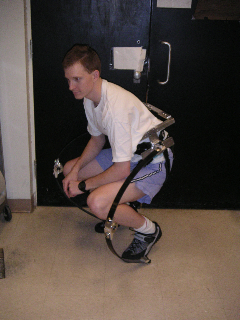Running is more efficient than walking for humans wearing spacesuits on the moon, according to a new study. A laboratory simulation of moonwalking found that pressurized spacesuits act as springs for our legs, and on the moon this effect is most pronounced during activity where the knee is bending at a greater angle, such as running. These findings may help NASA develop more efficient and comfortable spacesuits for future moon explorers, while also assisting research in prostheses for amputees. And who knows, maybe it could even promote the first lunar marathon run.
Because of the constriction of spacesuits and lower gravity, human movement is different on the moon than on Earth. This was evident during the Apollo missions where astronauts had a hard time bending over to pick up rocks or labored as they walked, but ran or bunny-hopped across the lunar surface with relative ease.
To simulate these conditions, researchers Christopher Carr and Dava Newman from MIT used an “exoskeleton” made of fiberglass rods and springs and placed them on the legs of a research subject. This exoskeleton was developed in large part by another MIT researcher, Dr. Hugh Herr in his study of prosthetics for amputees.
“We demonstrated that exoskeleton legs are similar to space suit legs, and that space suit legs act like springs due to the pressure of the space suit,” Carr told Universe Today. “Because of this, space suits support their own weight, but are hard to bend, making it difficult to carry out basic actions like picking up a tool from the ground.”
Carr is looking at ways to optimize the balance between stiffness and weight support to help the locomotive abilities for space-suited lunar astronauts. Less stiff spacesuits would enable easier ground access, but if they aren’t stiff enough, the suit will not support its own weight. Carr said the balance might be achieved with a change in the geometry of the space suit legs.
What else does this mean for future lunar exploration? During the Apollo missions there was a requirement of a walk-back constraint. Imagine a circle with an astronaut at the center, with the radius of the circle determined by how far you could walk while using only an emergency oxygen supply. This radius would specify how far away an astronaut could travel from their ‘base’, so that if a failure occurred he would be able to return safely. Now that we know running is more efficient than walking, said Carr, we should be able to base this constraint on running, allowing astronauts to travel further from their ‘base’, whether that base is their main habitat, or a pressurized rover.
Carr said he was somewhat surprised by their findings using the exoskeleton.
“I had not expected the forces imposed on the body by the exoskeleton to be so similar to the space suit knee joint,” he said.
They also used a simulated lunar gravity (1/6th of Earth’s) where the research subject wearing the exoskeleton was supported by cords attached to the ceiling by springs. “In this case, the subjects were even more efficient using an exoskeleton than walking or running without the exoskeleton,” said Carr. “We knew this was a possibility, but the proof is in the pudding.”
From this research it’s interesting to speculate about future athletic endeavors on the Moon. Running might be the sport of choice for lunar inhabitants, and the possibilities abound for lunar basketball. “Lower gravity might mean big jumps,” said Carr. “Even though our muscles will contract really fast, and thus will not be very efficient, we should be able to jump with a higher vertical velocity on the moon, maybe 30-50% faster than on Earth based on prior studies. Because gravity is 1/6 of Earth, that velocity will allow us to jump many times higher. We had better design those lunar habitats with high ceilings.”
Journal Reference: Science Direct


On your space suit legs: Locks and unlocks.
Keeping Geometry of your suits.
Asssuming that astronauts using exoskeleton will be able to jump higher and move faster, is there a limit (in time) to the use of the exoskeleton as changes occur in the bodies of the astronauts? That is, astronauts working at a future lunar base will expect to spend up to six months periods (at max), so will the exoskeleton be able to adust to the astronauts reduction in muscle-use due to working in a 1/6 gravity environment?
John — http://www.moonposter.ie
Moon News — http://www.moonposter.ie/news.htm
Doesn’t this rate several Koolness points? A direct result of the pioneering work in lunar survival quickly picked up by Buzz Aldrin during his first half hour on the Sea of Tranquillity. Someone is thinking and spending toward the end of returning to the moon…logically
I remember a while ago reading about how it’s most efficient to skip on the moon; it was even better than running. There’s no mention of that in this article.
i remboer hearing or seeing something about skipping too,
Though, given that most if not all lunar astronauts were military or ex-military, wouldn’t admitting to doing a bit of skipping be a TAD unmanly?
(I do like skipping actually…………….)